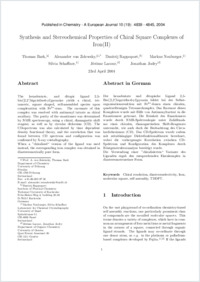Synthesis and Stereochemical Properties of Chiral Square Complexes of Iron(II)
- Bark, Thomas Department of Chemistry of the University of Fribourg, Switzerland
- Zelewsky, Alexander von Department of Chemistry of the University of Fribourg, Switzerland
- Rappoport, Dmitrij Institute of Physical Chemistry, University of Karlsruhe, Germany
- Neuburger, Markus Laboratory for Chemical Crystallography, University of Basel, Switzerland
- Schaffner, Silvia Laboratory for Chemical Crystallography, University of Basel, Switzerland
- Lacour, Jérôme Department of Organic Chemistry, University of Geneva, Switzerland
- Jodry, Jonathan Department of Organic Chemistry, University of Geneva, Switzerland
-
17.08.2004
Published in:
- Chemistry - A European Journal. - 2004, vol. 10(19), p. 4839-4845
Chiral resolution
Density functional calculations
Diastereoselectivity
Iron
Molecular squares
Self-assembly
English
German
The hexadentate, and ditopic ligand 2,5-bis([2,2']bipyridin-6-yl)pyrazine yields a chiral, tetrameric, square-shaped, self-assembled species upon complexation with Fe²⁺ ions. The racemate of this complex was resolved with antimonyl tatrate as the chiral auxiliary. The purity of the enantiomer was determined by NMR spectroscopy, by using a chiral, diamagnetic shift reagent, and by circular dichroism (CD). The CD spectrum was also calculated by time-dependent density functional theory, and the correlation that was found between CD spectrum and configuration was confirmed by X-ray cristallography. When a chiralised version of the ligand was used instead, the corresponding iron complex was obtained in diastereomerically pure form.
Der hexadentate und ditopische Ligand 2,5-Bis([2,2']bipyridin-6-yl)pyrazin bildet bei der Selbstorganisationsreaktion mit Fe²⁺-Ionen einen chiralen, quadratförmigen Tetramerkomplex. Das Racemat dieses Komplexes wurde mit Hilfe von Antimonyltartrat in die Enantiomere getrennt. Die Reinheit des Enantiomers wurde durch NMR-Spektroskopie unter Zuhilfenahme eines chiralen, diamagnetischen Shift-Reagenzes untersucht, wie auch duch die Beobachtung des Circulardichroismus (CD). Das CD-Spektrum wurde zudem mit zeitabhängiger Dichtefunktionaltheorie berechnet, wobei die vorhergesagte Korrelation zwischen CD-Spektrum und Konfiguration des Komplexes durch Röntgenstrukturanalyse bestätigt wurde. Die Verwendung einer chiralisierten Variante des Liganden ergab den entsprechenden Eisenkomplex in diastereomerenreiner Form.
- Faculty
- Faculté des sciences et de médecine
- Department
- Département de Chimie
- Language
-
- English
- Classification
- Chemistry
- License
-
License undefined
- Identifiers
-
- RERO DOC 4820
- DOI 10.1002/chem.200400399
- Persistent URL
- https://folia.unifr.ch/unifr/documents/299603
Statistics
Document views: 238
File downloads:
- Texte intégral: 307
